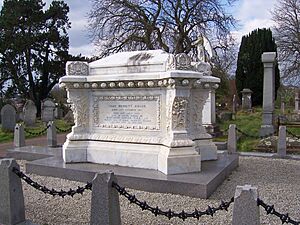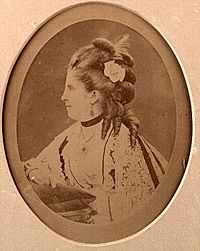Isaac Singer facts for kids
Quick facts for kids
Isaac Singer
|
|
|---|---|

Singer in 1869
|
|
| Born | October 27, 1811 Pittstown, New York, U.S.
|
| Died | July 23, 1875 (aged 63) Paignton, Devon, U.K.
|
| Known for | Founder of the Singer Sewing Machine Company |
| Spouse(s) |
Catherine Maria Haley
(m. 1830; div. 1860)Isabella Eugenie Boyer
(m. 1863) |
| Partner(s) | Mary Ann Sponsler (1836–1861) |
| Children | 26 |
Isaac Merritt Singer (born October 27, 1811 – died July 23, 1875) was an American inventor, actor, and businessman. He made very important improvements to the sewing machine. He also started the company that became the Singer Sewing Machine Company, one of the first big international businesses from America.
Many other inventors, like Walter Hunt and Elias Howe, had already patented sewing machines. But Isaac Singer's machines became popular because they were practical and easy for people to use at home. He also made them affordable by letting people pay for them over time.
Contents
Early Life of Isaac Singer
Isaac Merritt Singer was born on October 27, 1811, in Pittstown, New York. He was the youngest of eight children. His father, Adam Singer, was from Germany, and his mother, Ruth, was American.
When Isaac was ten years old, his parents divorced, and his mother left. At age twelve, he ran away from home. He found small jobs as a woodworker and machine operator. Later, he joined a traveling acting group called the Rochester Players.
Singer's Career and Inventions
In 1839, Isaac Singer received his first patent. This was for a machine that could drill rocks. He sold this invention for $2,000, which would be worth over $50,000 today.
With this money, he decided to go back to acting. He went on tour with his own acting group, the "Merritt Players." He used the stage name "Isaac Merritt." His partner, Mary Ann Sponsler, also acted with him. Their tour lasted about five years.
He later invented and patented a "machine for carving wood and metal" on April 10, 1849.
Developing the Sewing Machine
When he was 38, Isaac moved to New York City with Mary Ann and their eight children. He hoped to sell his wood-cutting machine. He got money to build a working model. But sadly, the steam boiler in the shop exploded, destroying his machine.
A partner named G. B. Zieber convinced Singer to try again in Boston. In Boston, Singer saw sewing machines being built and fixed in a shop. These machines were hard to use. Singer realized that a sewing machine would work better if the needle moved straight up and down, and the shuttle moved in a straight line.
He quickly improved the design and received a patent for his sewing machine on August 12, 1851.
Starting I. M. Singer & Co.
By 1856, several sewing machine makers, including Singer, were suing each other over patents. A lawyer named Orlando B. Potter suggested they work together instead. This led to the first "patent pool." This meant they shared their patents so they could all make complicated machines without legal fights.
They formed the Sewing Machine Combination. They also had to get Elias Howe to agree, as he held important patents. Howe received a payment for every sewing machine made.
Sewing machines then began to be made in large numbers. I. M. Singer & Co. made 2,564 machines in 1856. By 1860, they made 13,000 machines at a new factory in New York. Later, a huge factory was built in Elizabeth, New Jersey.
Making Sewing Machines for Homes
At first, sewing machines were mostly for factories, making clothes, shoes, and other items. But in 1856, smaller machines were made for home use. However, they were very expensive, costing over $100 (which was a lot of money back then).
Singer invested a lot in making machines using "interchangeable parts." This idea was used by Samuel Colt for firearms. By doing this, Singer could cut the price of his machines in half. He also made more profit. Singer was the first to sell a sewing machine for families, called "the turtle back." Eventually, the price dropped to just $10.
His business partner, Edward Cabot Clark, came up with payment plans. People could pay for the machines in installments over time. This made sales skyrocket!
With sewing machines at home, women could make clothes for their families or to sell. Groups also started to help poorer women learn sewing skills to find jobs. Classes and pattern books became popular for women who wanted to be productive at home.
Singer's Global Expansion
I. M. Singer & Co. grew into Europe. They first started in Scotland, near iron factories that supplied parts. Later, they moved to Clydebank, near Glasgow, and built the world's largest sewing machine factory between 1882 and 1885.
This huge factory had two main buildings for making machines. It also had a 200-foot (over 60 meters) tall tower with the 'Singer' name and four clocks. This was the biggest four-sided clock tower at the time! The factory opened with 3,500 workers, making 8,000 sewing machines each week. It was connected directly to railway lines to help with shipping.
By the 1900s, this factory made 1.5 million machines that were sold all over the world. This helped the Singer company become one of the first American multinational corporations, with offices in places like Paris and Rio de Janeiro.
Later, as Singer machines became more affordable, sewing classes became very popular. By the 1940s, there were 24,000 sewing classes each year in the UK alone. The 1944 Education Act even made practical dressmaking a required subject for girls in schools. In the 1950s, there were "Singer Teen-Age Sewing Classes" to encourage girls to make their own clothes.
Changes to the Company
In 1863, the original I. M. Singer & Co. business changed. Edward Cabot Clark thought Singer's personal life might harm the company's growth. The business continued as "The Singer Manufacturing Company," with Singer still owning 40% of the shares and staying on the board.
In 1871, Singer bought a large estate in Paignton, England. He built a huge 110-room mansion called Oldway Mansion as his home. It had a hall of mirrors and beautiful gardens. His son, Paris Singer, later rebuilt it to look like the Palace of Versailles. This area became known as 'Singerton'.
Impact on the Garment Industry
Singer's improved sewing machine was the first to work really well. It could sew 900 stitches per minute! This was much faster than a skilled seamstress, who could only do about 40 stitches per minute by hand.
This invention helped start the industrial age of clothing and textile making. A shirt that once took fifteen hours to make could now be made in just one hour. However, some parts still needed to be finished by hand. Factories making too many items led to lower wages and job losses for some workers.
In 1911, most of the workers at the Clydebank Singer factory, mostly women, went on strike. They were protesting against increased work and lower pay. Even though the strike didn't fully succeed, Singer fired 400 workers, including the union leaders. This strike was an important event in a series of protests known as Red Clydeside.
In the 1960s, Japanese companies started making lighter, cheaper sewing machines with aluminum bodies. These sold better than Singer's cast-iron machines. The famous Singer tower at the Clydebank factory was taken down when the factory was updated. The factory closed in 1980 and was later torn down in the late 1990s.
Personal Life of Isaac Singer
Isaac Singer died in 1875. He had a large fortune of $13 million. He divided his money among 20 of his living children. He had a total of 26 children.
His funeral was very grand, with eighty horse-drawn carriages and about 2,000 people attending. He was buried in Torquay Cemetery in a special tomb.
Legacy and Honors
- A World War II ship, the SS Isaac M. Singer, was named in his honor.
- Singer Island, Florida was named after his son, Paris Singer.
Images for kids
See also
 In Spanish: Isaac Merritt Singer para niños
In Spanish: Isaac Merritt Singer para niños





